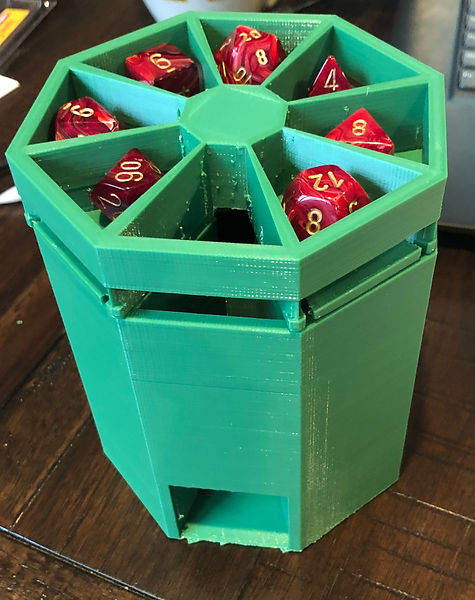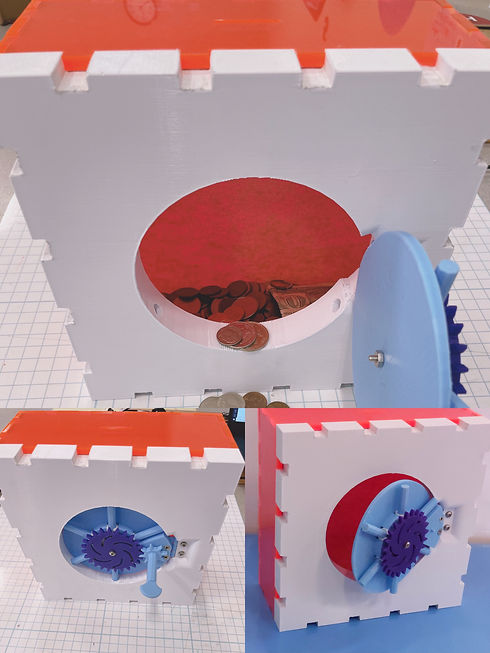Rose-Hulman Key Projects
While at Rose-Hulman Institute of Technology, I majored in Engineering Design and minored in Mechanical Engineering. Through these programs, I was able to work on a wide array of projects with an equally wide array of people in multidisciplinary teams. On this page I will goes through a number of my favorite projects from this time.
REACH PROJECT
The Character Curtain
The Character Curtain is a toy designed by my partner, Sophie Bear, and me during my first year at Rose-Hulman Institute of Technology. This toy was made for Reach Services’ Lending Library, a library of toys and tools that their therapists can use to engage kids with physical and/or mental disabilities in play. This toy was designed to appeal to kids who are on the autism spectrum and to help kids with their fine motor controls. The feeling of the chains and the sounds of the characters clinking together gives a satisfying and calming feeling, and a therapist can work with kids in moving the varying sized key rings and clasping and unclasping the chain connectors to work on fine motor control.
Contributions and Key Learnings:
For this project, we implemented voice of customer design by visiting the kids and therapists multiple times throughout the design process. We also created full documentation of stakeholders, needs, product safety tests according to relevant standards, Life Cycle Analysis report, and a bill of materials. I also was able to put my shop skills to use as we used the machine shop to hand make every part of the end product. This being one of my first major projects, I learned a lot about design research, user experience, and voice of the customer design.
This particular project got quite a bit of news coverage in the area surrounding Rose-Hulman, some links to those articles are listed here:
Terre Haute Tribune-Star, 11/8/2019 (front page),
Washington Times-Herald, Washington, Ind., 11/8/2019,
Anderson Herald-Bulletin, Anderson, Ind., 11/8/2019,
New Albany/Jeffersonville News and Tribune, 11/8/2019.


HRC PROJECT
Recall-O-Coin
During the Winter quarter of Freshman year, we worked with adults with mental and/or physical disabilities. We were tasked with designing and creating a product that would help our individuals with their jobs. My group's individual had a hard time remembering which tasks he was to do and in which order. After learning that they loved games, coins, and gumball machines, we designed the Recall-O-Coin.
To the right is the Recall-O-Coin, a tower-shaped device, akin to a gumball machine, which cycles between 4 or more tokens, which have pictures of tasks on them, in an unchanging order. During a task, our client would have a token with the current task in his possession, and once the task was completed, he could drop the current token at the top of the device and, at the bottom, the token for the next task would drop out. They'd get the next coin by turning the gumball machine type of lever, which would have the next task on it.
Through this project, I learned how to better talk with and understand those with disabilities, and how to understand what someone wants when talking with them to better provide them with a product they will be happy about. This project also enforced the practices of working together in a group.
INDEPENDENT DESIGN PROJECT
D&D Dice Rook Tower
The D&D Dice Rook is a dice tower that rolls a dice based on what buttons the user presses on the remote control and is inspired by the rook in chess and dice towers used for a variety of table top games. I used this project to help learn how to use stepper motors, and how to write code in C++. I used SolidWorks to model all of the parts and then printed them all using a 3d printer. The tower worked off of an Arduino Uno board running off of my code. This integrated an IR receiver, stepper motor, and a servo motor to make the product work.


DREAM PROJECT
Extended Laptop Screen Display
For this project, we were told to intentionally "dream big." We were to think of a product that we wanted to make but clearly didn't have the time for. Then we worked to see what was the most important part about that design that we could go in-depth with. To decide this, we made a Pugh Chart, a Stakeholder Emotions Map, and a House of Quality. After designing this part, we made a math model and a manufacturing report for the design as a whole.
My partner, and I decided that we wanted our dream project to be a second monitor attached to the back of our laptop. This, of course, wasn't a new idea, but there was something about most of the designs that we didn't like, there's a hanging wire. We didn't like the hinging wire, or the extra bulk some second monitors seemed to add onto their laptops, so we wanted to design one that was thin, and hid the wire within its housing. This being made specifically for our school laptops, the Lenovo ThinkPad P1, we were able to model everything off of them. Through our modeling in SolidWorks, and the different documents mentioned above, we came to the conclusion that we needed to narrow our scope to just the plug that would plug into our laptop.
For this, we knew that the wire would plug into a USB-C port, as it's shown to be better than a USB-A for this application. The problem was that we didn't want it to stick out of the laptop too much, and it needed not to interrupt the ports around it, so we designed a new type of plug to do this. It would plug into the USB-C port on our computers, go down, and use a protected ribbon cable to run along the bottom bevel of our laptops, and then into the housing of the screen. This would allow for minimal profile extension and a cleaner smoother finish.
I learned a lot through this assignment; I learned how to use a Pugh Chart and a House of Quality to determine the most important aspects of the design, and I learned how to focus on the most important parts of a design while keeping the design as a whole in mind.
Finally, after we finished our projects, we gave our presentations, which you can watch here (Timestamp: 1:40:50 to 1:50:00). Other presentations are also shown, such as my classmates, and the freshman class as well, though if you wish to watch our presentation, I suggest the use of the timestamp.
ENGINEERING GRAND CHALLENGES
Learn Mechanical Systems Through Toys
This quarter we took a look at the James Dyson Design Challenge and the NAE Grand Challenges for Engineers. We were to choose a Grand Challenge to work on as a submission to the Dyson competition. My group and I chose the Grand challenge of "Advance Personalized Learning." We decided that we would make something that would help people from younger high school-aged to adults learn more about mechanical systems and mechanical engineering. Our idea was to create puzzles and toys that would showcase some concept of mechanical systems so that they would have experience putting the system together, and learning how it all works together. We came up with 4 puzzles/toys in total, and we decided that 4 was a good number to make a set. The greater idea would then be that the customer would buy a set of puzzles/toys with their instructions, and then use these to learn a broad variety of things.
The puzzle/toy that I spearheaded is shown to the right, it is called the Coin Vault. As the name would suggest, it is a piggy bank of sorts, but shaped to look more like a vault. This is designed to teach about gears and how they work together. It also showcases circular to linear motion through the use of a modified expanding pully, not the best use for a vault, but it teaches the concept simply and it looks cool.
HERE is our group's video submission for Engineering Puzzles, which contains the other 3 puzzles/toys by Steven Xia, Jixi Wang, and Jesus Capo.
Through this project, I was able to get a lot of practice with my SolidWorks skills, my team management skills, and my documentation skills.
